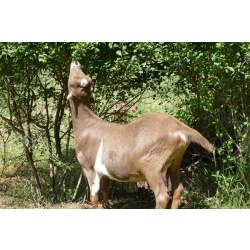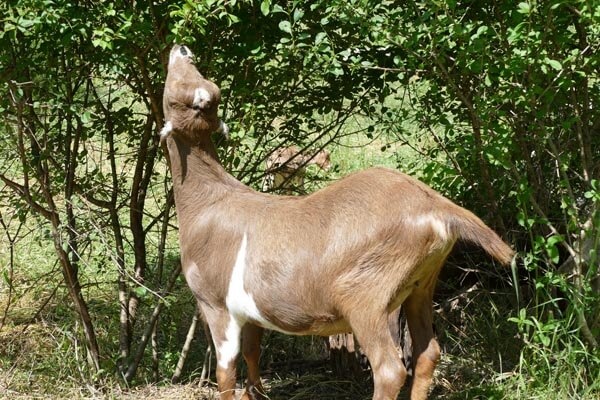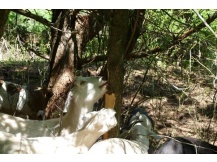
decorahnews.com feature story: A flash mob of goats at Luther College's Roslien Woods is eating everything in sight
Posted: Sun, Jul 5, 2020 1:00 PM
(Story by decorahnews.com's Carina Yee):
A herd of goats has been introduced to Luther College's Roslien Woods to "flash graze" the land and decrease the amount of invasive plant species.
"This 'mob grazing' or 'flash grazing' is intense grazing for a short period of time that targets woody species, including European buckthorn and Amur honeysuckle," says Luther College Associate Professor of Biology and Natural Areas Land Manager Molly McNicoll.
Decreasing the invasive species population in the woodland will allow for growth of native species by creating less competition for sunlight and space.
However, the goats feast on everything in sight -- not just the invasive species. They don't care if it's toxic wild parsnip, chemically-inhibiting buckthorn, or just plain old grass. Despite eating all of these potentially harmful plants, the goats have shown no signs of being affected. "I'm so impressed with goats," comments McNicoll, "Their stomachs are pretty well known for being tough as steel."
Another advantage of goats being indestructible is that they have no problems digesting tree bark. To eat the bark, they have to strip it from the trees in a process called girdling (and don't worry, the trees can't feel that they're being eaten alive by hungry goats). Girdling still allows nutrients to flow up the tree, but the nutrients can't go back down to the roots. As a result, the roots can't fill up their nutrient stores which are used to produce new shoots in late summer.
Not only do goats eat trees alive, but they also hunt in packs. One goat stands on the base of the buckthorn's wrist-sized branches to bend the tree down to goat-height while others gnaw away at its leaves and buds.
With the goats (literally) clearing the way, Luther can reduce its herbicide use to target individual plants instead of having to spray it on the entire woodland. After that, they plan to plant native species such as milkweed to restore the woods to its natural state.
The first goat feast began on June 22nd and will be followed by a rest period until the goats are moved to a new buffet site in August or September.
Copyright © - decorahnewsarchive.com. All rights reserved.| Terms Of Use Statement.

Site designed and maintained by Iroc Web Design Services©.
Your Small Business Web Design Solutions.™
Site designed and maintained by Iroc Web Design Services©.
Your Small Business Web Design Solutions.™





